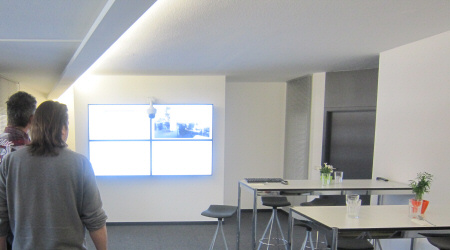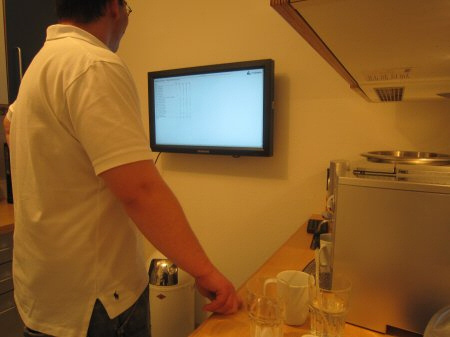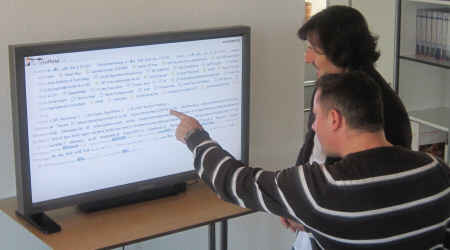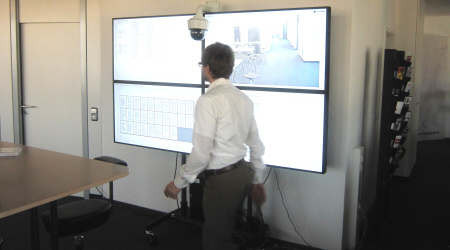We have to turn our databases inside out. As long as we are only saving (and not using) information, the time and effort we have spent producing and storing it was all for nothing. Read more about these and other findings from our large-screen monitor projects …
The eye-brain system is an image- and data-hungry monster that readily devours large quantities of information. That’s why I think that an ideal office should have walls made of monitors. Whenever you look at a wall or walk through the corridors, you learn something new. If your thoughts are somewhere else, then you don’t. An office would be like a forest or a park – and we would be the forest rangers or gardeners within it. Walking would be seeing. Seeing would be understanding. In production, it’s always been that way. When the head of production hurries through the production plant, a simple glance tells him or her much more than they could ever take in in numbers.

Our “Cafeteria Gate”. The information we post here is easy to digest and light on the stomach – such as good news from R&D and sales. That fits the surroundings.
Since we’d also like to achieve that, we have started to equip our office with large-screen monitors. In numbers, we have about one big screen per 80 square meters of office space – and plan on doubling that amount in the medium term.
We have installed different setups depending on where the monitors are located and how they are used. There are individual monitors as well as groups of 2, 4, 6, or 9 screens. We have already presented the “Gate“, which has 9 screens and is utilized by different workgroups as needed. We have also written about our “Mission Control Center“, which we use to monitor and control our business in real time.

Our “Kitchenette Monitor”: By the time our coffee is ready, we have already learned something new. Here, our departments report things that the others should know. That’s definitely 90 seconds well spent.
All of the other information kiosks present a series of reports, images, Web pages, short texts, and slides etc. – or are designed as news tickers that show numbers for different activities or information that you can put in short, concise messages. These kiosks get these news feeds on an automated basis from an information pool structured by topic, which our departments fill on their own. In addition, our financial controlling system generates reports that are updated on an hourly or daily basis and also displayed on the kiosk screens. Our Electronic Windows constitute a special form. These monitors show what’s going on in our other offices, just as real windows would.

Our “Ticker Portal”: Here, we get down to business with real-time data from our CRM and support systems.
In the meantime, the acceptance within our company is high. Our need for information is high. We also want to be informed about processes that go beyond our own areas of responsibility. That increases transparency, understanding, and trust. The standard information channels are already overloaded beyond despair. We need to find new capacity – and that’s much easier than we originally thought. We spend a lot of time in places where we would have time to consume information but aren’t offered any. People can absorb many tidbits of information very quickly when it is presented the right way. Plus, they can also choose to walk on by, pause for a moment, or even take a long, close look in extreme cases.

Our “Electronic Window” keeps us connected to colleagues in other locations.
We think that the largest information gains came from our kitchenette. Listening to the sound of coffee beans grinding can get very monotonous, and in the 90 seconds that it takes to get a cup, you can easily absorb three to five items of new information.
Stop by for a visit – and see for yourself how you can transform offices into parks.
